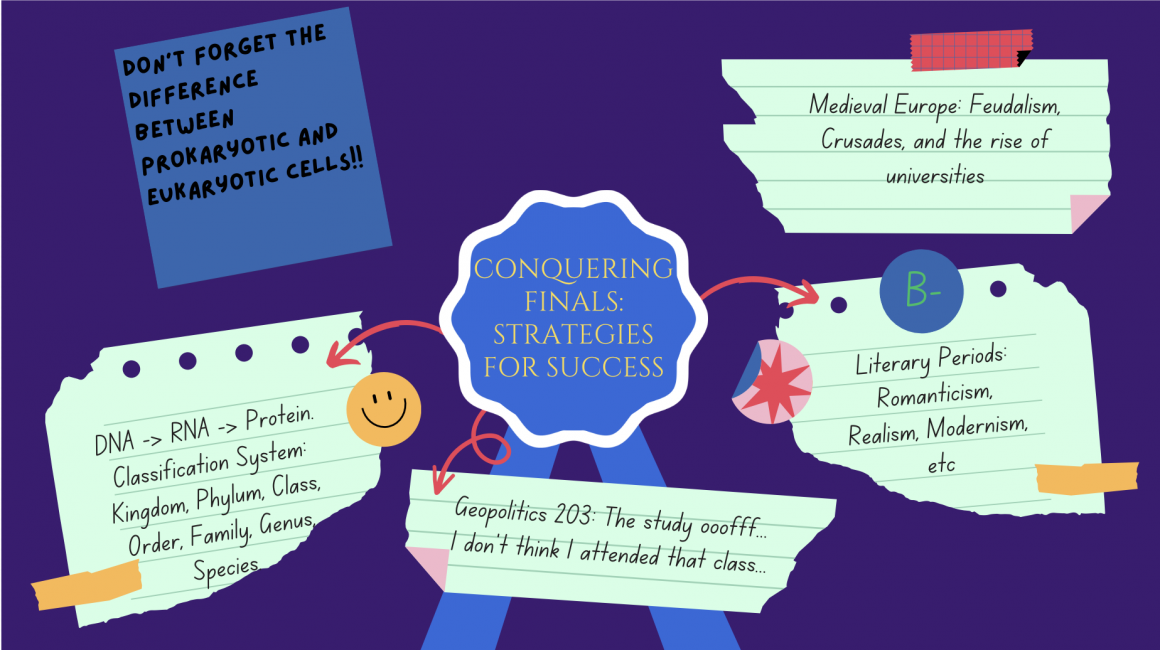
Conquering finals: Strategies for success
By Radhya Comar, April 20 2024—
Whether you’re in the arts, sciences or business, there is one thing that unites students across disciplines: Their mutual hatred and overwhelming dread of finals. Before students can embark on their summer adventures, they must get through almost two weeks of nonstop studying. Of course, these two weeks can look different for everyone. While some students have to confront tedious multiple-choice exams that test them on every tiny detail from a textbook, others are cranking out essay after essay and finishing up final projects. Because of the wide range of examination styles, there are countless study methods out there.
Simply put, some work and some don’t. Some of them do not account for shorter preparation timelines or the constant interruptions that come with trying to study in a shared dorm. To combat this study guide gap, this list amalgamates all sorts of techniques. It accounts for different types of learners and the testing styles prevalent in each program. With tips and tricks ranging from all different eras, these strategies are sure to get you out of your studying rut.
The Leitner System
For all of the academic weapons out there looking to start studying ahead of time, the Leitner System is one of the best methods out there. Developed by science journalist Sebastian Leitner, it is great for students who must cover a wide range of concepts and struggle with memorization. Essentially, the Leitner System relies on flashcards and boxes. Those who prefer to study online can produce digital flashcards and organize them into electronic folders rather than boxes. To begin, a student will create flashcards of all the terms and concepts they need to cover. They will begin by placing all of these cards in one box and going through them. The terms that they can define instantly and comprehensively can be placed in the third box. The cards placed in this box only need to be reviewed every week. Those that they can recall but are unable to completely elaborate on will be placed in the second box, to be reviewed every other day. Lastly, the terms that evade them completely should be kept in the first box to be studied every day. The amount of boxes or the amount of time between reviews can be left up to the discretion of the student. However, the central principle concept remains the same. The Leitner helps students identify their strengths and weaknesses. Since they can produce flashcards that have important dates, events, terms, theories or formulas, it is an aid to students of all disciplines.
The Pomodoro Method
The Pomodoro Method is commonly used by many students. It was created in the 1980s by Francesco Cirillo as he struggled with his own university workload. The approach is simple. Students will work for 25 minutes and then reward themselves with a five-minute break. After four 25-minute sessions, they can take a longer 15-30 minute break. The Pomodoro Method breaks down large intimidating tasks into more digestible 25-minute intervals. This makes it easier to start chipping away at your to-do list. The five-minute breaks also aid in productivity. With this limited time, students will only fulfill their immediate needs such as using the restroom or eating a quick snack before returning to work. However, the technique cannot account for the many uncontrollable interruptions that may arise from studying in a shared space. It can also be difficult to use for students writing final essays as the breaks between intervals may interfere with their train of thought.
The SQ3R Method
The SQR3 Method is specifically designed to help students absorb information from textbooks. In other words, it is designed to help them circumvent pesky professors who test every obscure detail from the textbook. SQ3R is a reading method first put forth by Francis Pleasant Robinson. It involves surveying, questioning, reading, reciting and reviewing. SQ3R requires a student to first skim through the chapter and survey the different subheadings and images. This primes their brain for the reading they are about to do. Each subheading must then be turned into a question. For example, it can be as simple as asking what the listed topic is or what its causes are. Then, the student will actually read the chapter. While doing so, they must try and answer the questions they formulated earlier. As they find answers, they should recite them and write them down. Finally, a student needs to review the notes they made while answering the questions. They should then be able to recite the chapter’s main points from memory. This, of course, is not beneficial for textbooks which outline concepts that must be applied practically such as those in math or science.
While everyone is different, these methods can help provide a starting point for your final preparations. They can help create a study plan which helps manage stress levels during this busy time. Of course, test scores are not always a true reflection of one’s intelligence or effort. Nonetheless, it is important to put your best foot forward.
